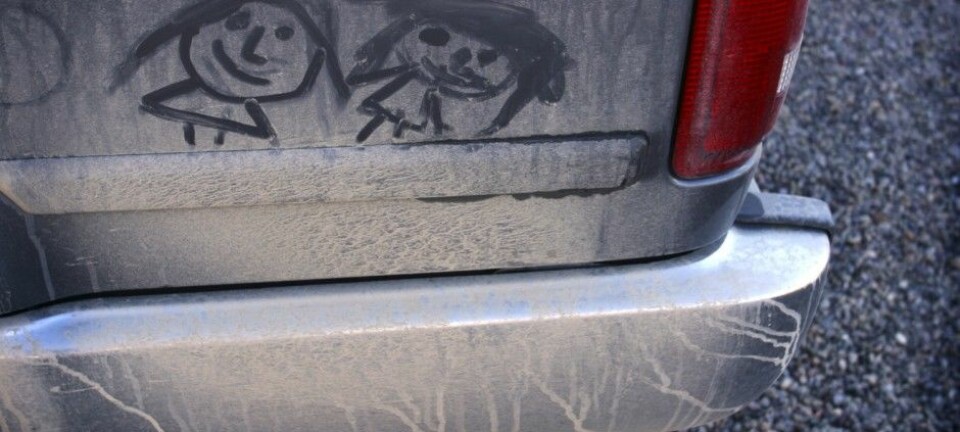
Is it dangerous to eat food grown right by the road?
A reader wonders how pollution affects the food crops that grow along Norwegian roads.
Air pollution needs to be taken seriously. Factories and exhaust pipes spew out particulate matter and gases that lead to around 6.5 million deaths a year, according to a report from the International Energy Agency.
The air quality and pollution in some parts of Oslo have been so bad on occasion that the municipality has introduced diesel bans on the worst days.
But lots of cars, trailers and buses run on highways and county roads, spreading pollution across Norway. Does the pollution harm the plants and get into our food?
Many types of pollution
CO2 has come to symbolize vehicle traffic emissions, and is considered the big culprit when we talk about global warming and man-made climate change.
But CO2 is something quite different for plants.
"This is plant food," Erik Joner tells forskning.no. He is a senior researcher at the Norwegian Institute of Bioeconomy Research (NIBIO), and has been studying how plants absorb pollutants.
Plants need CO2 to drive photosynthesis that keeps them alive, so CO2 emissions give plants more to work with.
Studies of food crops growing in urban environments have shown that these plants have a longer growing season than plants grown outside the city, according to a research summary from 2013.
The enhanced growth may be due to higher CO2 levels and slightly higher temperatures in the city, which provide better growing conditions.
NOx
Motor vehicles are also primary sources of nitrogen oxides (NOx). They form particles and create smog in cities that are toxic to humans. But nitrogen is an important nutrient for plants.
"NOx aren’t a problem for agricultural plants, since nitrogen binds to the soil and has a fertilizing effect on the plants,” says Joner.
Nitrogen is an important ingredient in synthetic fertilizers.
But nitrogen can become too much of a good thing. A German study from 2006 shows that excess nitrogen disturbs ecosystems in coniferous forests.
Particulate matter
What about all the dust coming from the roads?
Motor vehicle traffic emits several types of particulate matter, including carbon that comes from fuel combustion in the engine.
A small proportion of these particles are called polycyclic aromatic hydrocarbons (PAH). These chemicals may cause certain types of cancer, including gastric and lung cancer.
The particles become part of the road dust that disperses onto nearby vegetation, but they don’t directly affect the plants so much.
"The dust that lands on the plants means the plants get less sunlight," says Joner, making photosynthesis slightly less effective.
“It's smart to wash lettuce that’s been exposed to this dust, so we don’t ingest it,” he says.
According to this PAH review from 2015, PAH particles’ rate of transfer to plants varies widely, depending on soil characteristics, the plant and other pollutants. Most PAH are fat soluble rather than water soluble, meaning they can easily be absorbed by humans and animals but less so by plants, which absorb nutrients via water in the soil.
Pollution from vehicle traffic can change some plant properties, such as chlorophyll content and how quickly the leaves age. This can affect plant health, but not the health of those consuming the plants, according to researcher Sam Wortman's 2013 review.
Lead
Cars and industry also emit other plant contaminants, such as heavy metals.
For many decades, lead was added to gasoline in Europe and the United States to help engines run more smoothly, but this practice ended in the 1990s. However, lead stays in the soil for many years, and thus it continues to be a serious environmental hazard.
Lead poisoning is a dangerous condition that can lead to personality changes and brain injury.
"Many plants don’t have any transport routes be able to absorb lead, so not much lead gets into the plant,” Joner says.
But washing the plants is important. Most of the lead contaminants are in the soil on the outside of the plant, like with carrots, for example.
“You’ll ingest a little more lead if you don’t peel carrots grown in lead-contaminated soil, but it’s minimal,” he adds.
Copper and zinc
Joner has also been researching how much copper and zinc is being transferred into grains.
Copper and zinc are vital minerals, but too much becomes toxic. Car brakes and tires contribute to the copper and zinc dust along roads.
"In our project we fertilized fields with sewage sludge that contained small amounts of zinc and copper,” Joner says.
Humans need copper, and the daily recommended dose is around two milligrams.
"If you made bread from the grain we studied, you would have to eat five kilos of bread a day just to get the daily dose,” he says.
In other words, you’d have to consume a lot of bread before copper became dangerous.
Other metals
However, plants react differently to different types of heavy metals. The amount of heavy metals that the plants absorb, for example, depends on the soil’s pH value.
Cadmium is an example of a metal that is toxic and more water soluble, meaning that plants can take it up and humans can thus ingest it through plants.
Alum shale, such as is found in southeastern parts of Norway, contains naturally occurring cadmium. Vegetables and grains both take up the cadmium present in the soil. We say that the transfer factor for cadmium is high, while it is very low for lead.
Nibio tests how much cadmium is actually absorbed by plants and if it poses a risk to people and animals.
Cadmium is found in car tires, but in only very small amounts, according to a Swedish doctoral dissertation from 2008. Researcher David Hjortenkrans writes that the amount of cadmium pollution has decreased, probably due to EU regulations.
Cadmium is used to produce batteries and in other industries. Japan has done a lot of research on cadmium in rice where elevated values have been detected in the soil and in crops, due to industrial emissions.
Heavy metals and environmental pollutants are a major problem where industrial emissions are greater. The Norwegian Environment Agency has made a map of the most polluted sites in Norway.
Joner recommends that people avoid growing food in these places.
Roads and salt
Joner believes salting roads in the winter is the most harmful pollutant for vegetation near roadways.
“Salt is water-soluble, so the plants take it up through the roots, and plants don’t tolerate salt water,” he says.
This is only a problem where roads are salted, of course.
"All in all, plants are pretty resistant to pollution. It’s important to keep an eye on heavy metals and PAH pollutants, but we haven’t found reason to worry about much else,” Joner says.
The Swedish doctoral thesis on heavy metals concludes that small amounts of heavy metal dust are evenly distributed along the roadways, but that dispersal distances are limited. Most metals in fields are found within ten meters of the road.
The good news is that motorized traffic probably doesn’t create enough pollution to destroy the food that grows along the road. But it's still a good idea to wash our vegetables.
-------------------------------------
Read the Norwegian version of this article at forskning.no
Scientific links
- Wortman, S.E. and Lovell, S.T: Environmental challenges threatening the growth of urban agriculture in the United States. Journal of environmental quality (2013) Abstract.
- Abdel-Shafy, H.I. and Mansour, M.S.M.: A review on polycyclic aromatic hydrocarbons: Source, environmental impact, effect on human health and remediation. Egyptian Journal of Petroleum (2016) Abstract.
- Hjortenkrans, D.: Road traffic metals - sources and emissions. Dissertation at University of Kalmar, Sweden (2008)
- Uraguchi, S. and Fujiwara, T.: Cadmium transport and tolerance in rice: perspectives for reducing grain cadmium accumulation. Rice (2012) Abstract.

































